
syzygy
Join astronomer Dr Emily Brunsden and enthusiastic not-astronomer Dr Chris Stewart as they explore the universe.
- Update frequency
- every 13 days
- Average duration
- 47 minutes
- Episodes
- 135
- Years Active
- 2018 - 2025

Episode 13: Neutrino Messenger from a Distant Blazar
In September 2017, two kilometres deep beneath the South Pole, a tiny but very speedy neutrino collided with an atom in the ice and created a flash of light. The flash was picked up by a few of the m…
00:35:34 |
Fri 20 Jul 2018

Episode 12: The Light Fantastic
A question from a listener leads us into some very tall weeds as we ponder the nature of light: what is it, exactly? It is a wave? Or a particle? Or, somehow, both at once? And photons, the massless …
00:36:12 |
Fri 06 Jul 2018

Episode 11: Black Hole Eats Star, Then Burps
Black holes: a staple of quality science fiction for decades now ... but what actually *are* they? Awesome, is one answer. Astronomers reported a few weeks ago fresh evidence for a black hole tearing…
00:44:05 |
Fri 29 Jun 2018

Episode 10: So you want to be an astronomer?
It's episode 10! We celebrate with cake and a chat about how how astronomers become astronomers. Emily describes her (slightly unusual and a bit cheeky) path to her current career as Astronomer Extra…
00:44:05 |
Fri 22 Jun 2018

Episode 09: Life on Mars?
A few weeks ago NASA gathered journalists from across the globe for an announcement about something they'd found on Mars. Naturally, the collective imagination went *nuts*, because surely, SURELY thi…
00:38:25 |
Fri 15 Jun 2018

Episode 08: The Frozen Dunes of Pluto
At the XXVIth General Assembly of the International Astronomical Union, held in Praague in August 2006, a new set of three criteria were decided to define what is — and what is emphatically *not* — a…
00:38:04 |
Fri 08 Jun 2018

Episode 07 (supplemental): Octopuses from Space!
So, apparently, octopuses come from space. Or something. Emily and Chris chat about a ... curious ... paper that came out recently, which proposes an explanation for the Cambrian Explosion, the huge …
00:07:00 |
Fri 01 Jun 2018

Episode 07: Plumes of Ice on Europa
Some astronomers found signs of great plumes of water erupting from the surface of Europa, one of the larger moons of Jupiter — and water could mean life, which has everyone jumping around in excitem…
00:43:13 |
Fri 25 May 2018

Episode 06: Galaxy Pile Up Causes Cosmic Chaos!
Astronomers have spotted a cluster of 14 galaxies far, far away, so piled up on top of each other, and so soon after the Big Bang, that they’re forcing the theorists to check back over their models a…
00:32:06 |
Sun 20 May 2018

Episode 05: Diamonds from Space!
Back in 2008 a large chunk of rock hurtled into the Earth’s atmosphere. Most of it burned up on the way down, but some fragments of the meteorite landed in the deserts of Sudan. When scientists open …
00:31:39 |
Fri 04 May 2018

Episode 04: The Music Of The Stars
TESS made it! The little satellite with the big heart is now in space, gradually getting into its final orbit to start gathering data. And Emily is excited, because alongside all the exoplanet data T…
00:32:37 |
Fri 27 Apr 2018

Episode 03: Holding Our Breath For TESS!
After a quick listener question from Graham in Highfields, Australia, this week’s show is all about TESS: The Transiting Exoplanet Survey Satellite.
TESS is a brand new space telescope that, at the t…
00:38:56 |
Thu 19 Apr 2018

Episode 02: Dark Matter Is Out There, Even When It's Not
A cosmic riddle for you: When does not finding something where you expect to it to be tell you that it exists?
In the 1960s and 70s, astronomers measured the speed of stars and gas clouds orbiting a…
00:29:41 |
Fri 13 Apr 2018

Episode 01: Planets, in a Galaxy Far, Far Away
In this, the first proper episode of Syzygy, we’re talking planets: near, far, and very, very far. While the number of planets in our own solar system went from nine to eight (poor Pluto …), over the…
00:33:41 |
Thu 05 Apr 2018

Episode 00: A Syzygy Sneak Peek
syz·y·gy (sĭz′ə-jē), noun: an alignment of three celestial bodies, such as the sun, moon, and earth during an eclipse. Also: a podcast wherein real-life, actual astronomer Dr Emily Brunsden from the …
00:03:21 |
Tue 03 Apr 2018
Disclaimer: The podcast and artwork embedded on this page are the property of Chris Stewart. This content is not affiliated with or endorsed by eachpod.com.